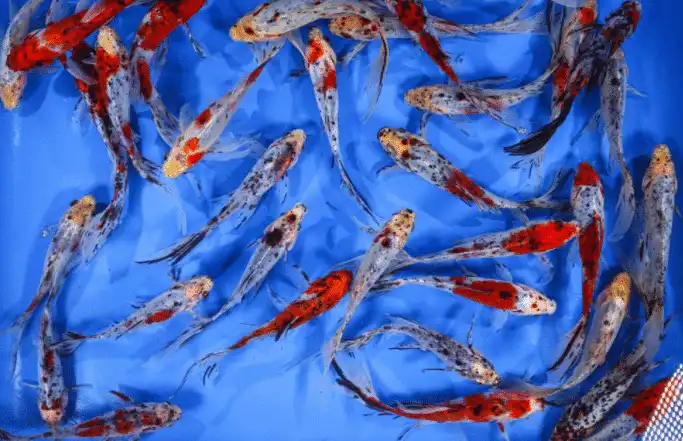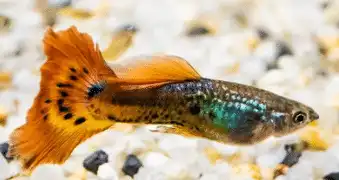Thank you for visiting! By the way… any links on this page that lead to products on Amazon and other stores/partners are affiliate links Aquarium Store Depot earns a commission if you make a purchase.
Do you find yourself constantly battling algae growth in your beautiful garden pond? You’re not alone! Keeping a clean and healthy pond can be a challenge, but did you know that adding some algae eating fish to your pond can help keep it crystal clear? In this blog post, we’ll explore the top 10 algae eating fish for ponds, along with some additional pond inhabitants, and discuss how to choose the right species for a clean and balanced pond.
Key Takeaways
- Understanding algae growth in ponds is essential for keeping it under control.
- Consider pond size and environment, compatibility with existing inhabitants, climate & temperature requirements when selecting an algae eating fish.
- Regular maintenance like water testing and proper feeding can help keep your pond healthy!
Understanding Its Growth
A problem pond owners often face is algae growth in their ponds. This mainly results from too much sunlight, nutrient rich water, and other environmental conditions.
To combat this issue, there are a few methods: introducing fish that eat algae can be incredibly effective as they feast on this algae while providing entertainment for you! It’s good to know the types of algae that grows in ponds and what causes it. This will allow you to select the correct type of algae eater and help you solve environmental issues first before you try to add livestock.
Types
Having the right algae eater is essential to manage different kinds of algae growth in your pond. For example, string algae can be a real eye sore as it attaches itself on rocks, waterfalls and plants. Blue-green algae might even pose harm for pets due to its toxicity – making their control vital. Green water tends to also accumulate often, though this type does not Cause any hazardous effects.
Green water cannot be treated with fish, you will need to resolve that with an UV sterilizer. String and filamentous algae can be eaten by livestock. Blue green algae is toxic and a cyanobacteria. Cyanobacteria indictates a big inbalance in your pond and require immediate attention. It will not be eaten by fish.
Causes
Algae blooms in ponds can be attributed to an overabundance of nutrients, such as nitrates and phosphates, due to runoff or fertilizer. A lack of water flow that enables the build-up of those same elements. And inadequate filtering which leaves residuals available for algae growth. Poor circulation permits these excesses settle leading into perfect conditions for the accelerated proliferation of said species. Insufficient filtration Boosts chances by allowing sustenance not cleared from waters remain behind inviting throngs more plant life.
Top 10 Algae Eating Fish for Ponds
Now that we understand the reasons for algae blooms and the different varieties we handle in the pond world, we can now talk about our list that contains the best 10 species for ponds which are renowned as adept consumers of pond algae.
We are covering all sizes of ponds here. From fish big suited to large ponds and even lakes to fish that can be placed in a patio pond. There is an algae eating pond fish for you on this list. Let’s get started!
1. Grass Carp (Ctenopharyngodon idella)

- Scientific Name: Ctenopharyngodon idella
- Care Level: Moderate
- Minimum Pond Size: 3000+ Gallons
- Temperament: Peaceful
- Adult Fish Size: 48″
- Temperance Tolerance: Up to 0 degrees F
Grass Carp are an ideal fish for large ponds because of their size, fast growth rate and appetite for aquatic plants and algae. They can grow up to 55 pounds, but are generally peaceful in nature. If you do purchase them, ensure the breeder has treated them. Treated specimens are sterile. This is done to control their numbers as they are very invasive if released into the wild.
These fish will eat many types of nuisance grass, including muskgrass and duckweed. It will generally not eat flimentous algae. It’s more of an invasive plant eater, and it does a great job at what it enjoys eating.
2. Dojo Loach (Misgurnus anguillicaudatus)
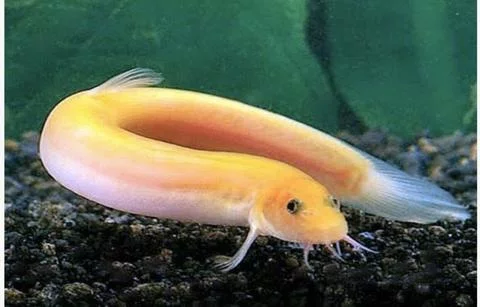
- Scientific Name: Misgurnus anguillicaudatus
- Care Level: Easy
- Minimum Pond Size: 200 Gallons
- Temperament: Peaceful
- Adult Fish Size: 12″
- Temperance Tolerance: Up to 40 degrees F
Pond Loach (also known as weather loach) are mild-mannered fish that enjoy residing at the bottom of a body of water. They mainly feed on algae and organic matter, while adapting to different ranges in temperature – from 68°F (20°C) up to 72°F (23°C). These resilient creatures can endure even if temperatures drop as low as upper 50’s Fahrenheit (13-15 ° Celsius), provided that pH level remains between 6.5 and 8.0. If your waters get closer than this during the winter, you will need to bring them in to survive. Fortunately, they are small enough to be housed in aquariums.
For optimal comfort for these peaceful swimmers, it’s suggested they live together with their own kind. Preferably, no less than six individuals per group or family unit is preferred by aquarium keepers alike!
3. Chinese High-Fin Banded Shark (Myxocyprinus asiaticus)

- Scientific Name: Myxocyprinus asiaticus
- Care Level: Moderate
- Minimum Pond Size: 1,000 Gallons
- Temperament: Peaceful
- Adult Fish Size: 48″
- Temperance Tolerance: Up to 0 degrees F
Chinese High-Fin Banded Sharks are best suited for large ponds, as they have slow growth rates and tolerate colder water temperatures. Preferred environments vary between 55 to 75 degrees Fahrenheit (13 – 24°C), however they can tolerate lower temperatures during the winter time. These fish feed on algae and exhibit docile behaviors with their tankmates. As such, there’s no need to worry about aggression from these high fin banded sharks when it comes to aquarium inhabitants sharing a home in the same space!
This is a large fish with a large appetite for algae. As long as you have a big enough pond, it will be up for tackling your algae problem!
4. Common Pleco
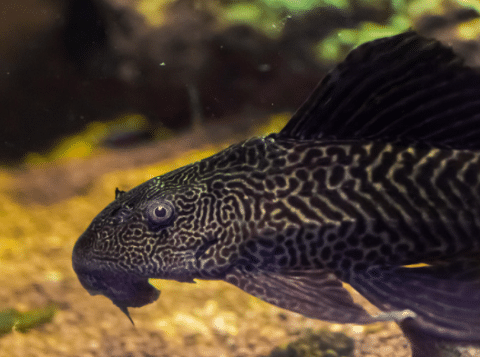
- Scientific Name: Hypostomus plecostomus
- Care Level: Moderate
- Minimum Pond Size: 300 Gallons
- Temperament: Peaceful
- Adult Fish Size: 24″
- Temperance Tolerance: Up to 50 degrees F
The Common Pleco is a resilient, adaptive fish species that has an adapted mouth structure for efficiently feasting on algae. To ensure the best well being of these creatures in their pond environment, it may be necessary to maintain warmer water and provide them with more spacious dwellings. They are best suited to be in ponds where the outside temperature is more stable in the winter. They going to be too large to be placed in a temporary aquarium during the winter.
5. Bristle Nose Pleco

- Scientific Name: Ancistrus spp
- Care Level: Easy
- Minimum Pond Size: 150 Gallons
- Temperament: Peaceful
- Adult Fish Size: 6″
- Temperance Tolerance: Up to 40 degrees F
Bristle Nose Pleco are a peaceful species that do well in tank conditions ranging from 68-82°F (20-28°C). They can tolerate cooler environments than the Common Pleco, with temperatures as low as 40°F (4 °C), making them an ideal choice for colder climates. These smaller fish love eating algae and require plenty of hiding places to feel safe and comfortable.
6. Shubunkin Goldfish
Editors' Choice
Coloration, patterns, and it's Koi-like features make this goldfish one of the most popular for ponds
- Scientific Name: Carassius auratus
- Care Level: Easy
- Minimum Pond Size: 180 Gallons
- Temperament: Peaceful
- Adult Fish Size: 6″
- Temperance Tolerance: Up to 0 degrees F
Shubunkin Goldfish are known for being vibrant and sociable fish, which thrive in an array of pond conditions such as cold water. They’re quite hardy creatures that can tolerate a variety of temperatures and will feed on algae along with other edibles. Keeping Shubunkins together is recommended because they enjoy the company of their peers.They will eat more algae during the winter than they will over the hotter months.
7. Guppies
An undemanding fish that is a livebearer. Many varieties available
- Scientific Name: Poecilia reticulata
- Care Level: Easy
- Minimum Pond Size: 20 Gallons
- Temperament: Peaceful
- Adult Fish Size: 1 – 2 inches
- Temperance Tolerance: Up to 55 degrees F
Guppy Fish can help maintain the algae level in smaller ponds, They may be susceptible to lower water temperatures. To keep them healthy and thriving it is important that their habitat temperature stays above 65°F (18°C). They can tolerate down to 55 degrees short term, but will need to be placed inside once temperatures drop.
They are an omnivorous species meaning that they have a varied diet including plant matter, insects, crustaceans as well as high-quality fish food supplemented with occasional treats such as brine shrimp or bloodworms. Only only do they control algae, but they are great at eating mosquito larvae.
8. Mollies
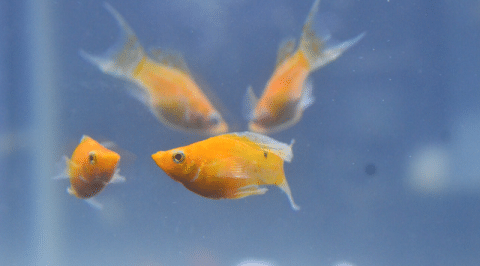
- Scientific Name: Poecilia sphenops
- Care Level: Easy
- Minimum Pond Size: 30 Gallons
- Temperament: Peaceful
- Adult Fish Size: 3 – 4 inches
- Temperance Tolerance: Up to 68 degrees F
Molly Fish are excellent at keeping algae growth in check and do their best when surrounded by plenty of vegetation. It’s wise to have several together since they’re very sociable creatures. These fish should be brought indoors in the colder winter months as they don’t tolerate low temperatures well. An important thing for them is a balanced diet that includes insects, small crustaceans, or anything else with an algae base, such as spirulina flakes or pellets designed specifically for aquariums.
9. Siamese Algae Eater
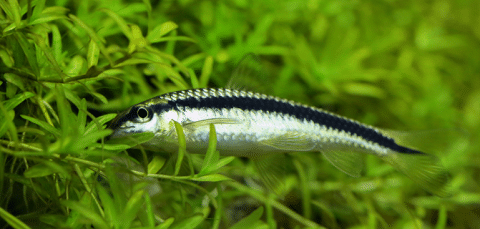
- Scientific Name: Crossocheilus oblongus
- Care Level: Moderate
- Minimum Pond Size: 100 Gallons
- Temperament: Moderate
- Adult Fish Size: 5-6 inches
- Temperance Tolerance: Up to 68 degrees F
Hardy fish, such as Siamese Algae Eater and Chinese Algae Eater from Southeast Asia, require warm waters to thrive. These species are excellent algae consumers, making them an ideal addition for smaller ponds where temperatures should range between 70-79°F (21-26°C). They are best housed in locations that stay warm throughout most of the year.
10. Mozambique Tilapia

- Scientific Name: Oreochromis mossambicus
- Care Level: Moderate
- Minimum Pond Size: 10 lbs per acre (not met for home ponds)
- Temperament: Moderate
- Adult Fish Size: 14 inches
- Temperance Tolerance: Up to 40 degrees F
For pond owners with lots of land, the addition of Mozambique Tilapia to their larger ponds can be beneficial as they are voracious algae eaters who will happily feed on algae blooms during warmer months. Because they are fish that do not live well during the freezing months and they are considered aquaponic, they serve a dual purpose.
Keep them for the warm months and when it gets cold, you can harvest them for food. They revert to their wild state when introduced to a large pond, which changes their taste and look. They are also easy to catch when it gets cold as their metabolism will slow down.
Additional Inhabitants
Maintaining a healthy pond environment involves controlling the algae growth, and our top 10 algae eating fish can be helpful in this process. Other beneficial creatures that could help with this are Japanese Trapdoor Snails and Mosquito Fish, both of which provide unique characteristics to assist you on your quest for an ideal balance.
Japanese Trapdoor Snail (Viviparus malleatus)
Japanese Trapdoor Snails are known for their hardiness and make an attractive addition to any pond. They consume algae, along with decaying matter which helps keep the water clean. These snails can tolerate a wide variety of temperatures, even surviving colder climates up north – they won’t overpopulate as well! But before introducing this species or other fish into your local environment, it is best to check in with Fish and Wildlife division since some may be deemed invasive species1.
Mosquito Fish (Gambusia affinis)
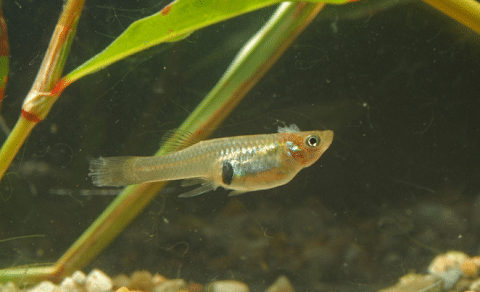
Koi and Mosquito Fish are small, hardy pond dwellers that feast on algae as well as mosquito larvae. They have the ability to withstand drastic temperatures in outdoor ponds, making them beneficial for controlling algae growth. They differ from regular guppies as they only reproduce seasonally, while guppy fish can reproduce anytime.
Factors To Consider
Choosing the right species for your pond is important, and it requires considering a number of factors such as size, compatibility with other creatures living in the pond environment, climate conditions, and temperature. Let’s take a closer look at these elements.
When picking out algae eating fish to add to our ponds we need evaluate if they are compatible with already existing inhabitants within that particular system. Consider space requirements (how large or small is one’s body of water); how their preferred temperatures align against current weather patterns? Doing this will enable us make informed decisions concerning which types of aquatic animals to add.
Size And Environment
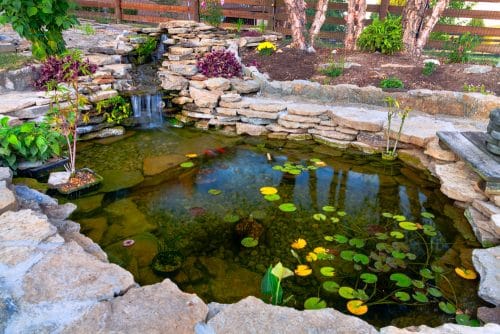
When selecting algae eating fish species, the scale of your pond and its environment must be taken into consideration. For instance, bigger ponds are better suited for Grass Carp, whereas Siamese Algae Eater is preferable in smaller bodies of water and in warmer climate. Check all the parameter requirements in this post so you select the correct fish for your environment.
Compatibility With Other Inhabitants
When introducing algae eating fish to an existing pond, ensuring their compatibility with other inhabitants is critical. Many of these algae eaters are bottom feeders, which means they are territorial to other fish that inhabit that space. It is best not to mix algae eaters that are bottom feeders with others to avoid any territorial disputes.
Climate And Temperature Requirements
When it comes to the type of algae eating fish species you choose for your pond, research is essential. Different varieties have diverse temperature requirements – some prefer temperatures over 65°F (18°C), such as Molly Fish. While others like Shunbunkins can cope with chilly 32°F (0°C).
It’s also important to note that any fish we listed can tolerate up to zero degrees Fahrenheit and withstand freezing temperatures as long as a de-icer is used to defrost a hole in the ice so gasses can escape the pond.
Alternative Control Methods
Algae growth in ponds can be regulated through the use of algae eating fish or alternative solutions like floating plants and UV clarifiers. Let us explore how these methods contribute to keeping a pond free from excessive amounts of algae.
Floating Plants
Floating plants are helpful in controlling algae growth by preventing the direct sunlight exposure to water, which is essential for algae to survive. They also absorb nutrients from the environment hence reducing its availability for algae development. Commonly used floating species of aquatic vegetation include lettuce-like Water Lettuce, similar looking Water Hyacinth and tiny Duckweed.
Aside from limiting unwarranted increase of algae population, these botanical floaters have an ornamental aspect as well providing secluded shelters. The major drawback is that you will have trouble seeing your pond fish. Placing your pond in a shaded area will also reduce algae from direct sunlight.
UV Clarifiers And Filtration Systems
By using UV light to kill algae and other microorganisms, as well as filtering out debris from the water with filtration systems, it is possible to control algae growth in ponds. This approach can improve the clarity of the pond’s waters and promote healthier fish populations due to reduced algae issues. To get maximum benefits from these techniques, though, one must take care when managing and observing them on a regular basis. Bulbs should be replaced regularly. UV systems are best against green water and also have a disease mitigation benefit if you purchase a high end system.
Maintenance Tips
Maintaining a healthy and balanced pond environment is essential for avoiding algae overgrowth, as well as safeguarding the health of all pond life. Water testing regularly along with right feeding habits and employing algae control methods such as floating plants or UV clarifiers should be considered to preserve an ideal atmosphere in your pond system.
Regular Water Testing
Monitoring water quality is a must to maintain the health of your pond and its inhabitants. Using a testing kit can help measure pH, ammonia, nitrite, and nitrate levels. Essential information for preventing algae blooms and other problematic conditions in ponds.
Water testing is your first defense against algae. You can check to see if your parameters are off and take appropriate action. You can also make water changes if parameters are off to rebalance the system. Note that one expert koi keepers who raise one of the finest breeds recommend 10% water changes a week with some going as far as 10% a day using auto water change systems2.
Proper Feeding Practices
Adhering to normal feeding routine can help prevent an excessive amount of nutrients and the growth of algae in your pond. Overfeeding could lead to a build up of nutrient levels, leading swiftly to unsightly algae bloom. To limit this problem, ensure that fish consume their food within minutes. Then remove any leftovers promptly so as not jeopardize water quality conditions.
The Best Value in Koi Food
Premium quality Koi food without the premium price. It's the best value on the market
Frequently Asked Questions
What is a good algae eating fish for a pond?
Algae-eating fish are a great choice for outdoor ponds, providing variety and an inexpensive way to bring life into the space. Koi Ponds, Pond Loaches, Chinese High Fin Banded Sharks and Flying Foxes as well Common Plecos all make excellent candidates that help maintain cleanliness while looking beautiful in your pond.
These species of algae eaters aren’t particularly challenging to care for, they can be found almost anywhere pet stores operate. Since these types of fish won’t break the bank budget wise it is easier than ever before to get creative when stocking up on different kinds of aquarium dwellers at home!
Plus even if you’re just starting out with keeping aquatic creatures there’s no need fear: Algae eating fishes like those listed above require only basic maintenance such as regular water tests ensuring good quality levels so you will never have troubles caring after them properly without experiencing too much effort doing this vital task itself!
Will algae eaters survive in a pond in winter?
Koi, goldfish and Chinese High-Fin Banded Sharks (Batfish) are all able to make it through wintertime successfully in both small and large ponds. These species can help keep the growth of algae blooms under control as well.
How do I get rid of large algae in my pond without killing fish?
To get rid of large algae in your pond without killing fish, you can try using beneficial bacteria, mechanical filtration systems, and manual removal techniques like skimming and netting.
For an all-natural solution, you can also add a bundle of barley straw which breaks down over time to clarify water and indirectly reduce algae growth.
How can I control algae in my pond?
To manage the algae in your pond, use an aerator to add oxygen and helpful bacteria. You can also physically remove decomposing matter with a net. Nutrient levels are key. Keep an eye on phosopate and nitrate levels. Keep your pond out of direct sunlight and keep temperatures stable. High temperatures will encourage more algae growth.
How do algae eating fish help control algae growth?
Algae eating fish are useful for controlling algae growth since they will consume it and other organic material, thereby keeping the pond clean. These aquatic creatures act as a natural way of regulating algae buildup so that waters remain clear.
Closing Thoughts
Adding algae eating fish to your pond can prove advantageous in creating a healthy, uncluttered environment. Depending on the size of the body of water and existing wildlife, an appropriate selection should be made when considering these aquatic species for controlling any excessive growths.
Have you had any luck with these algae eaters? Let us know in the comments below.
- About the Author
- Latest Posts
I’m thrilled that you found Aquarium Store Depot! Here you’ll find information on fish, aquariums, and all things aquatics related. I’m a hobbyist (being doing this since I was 11) and here to help other hobbyists thrive with their aquariums! I adhere to a high quality Editorial Process and Review products with real life field usage and practical analysis.


